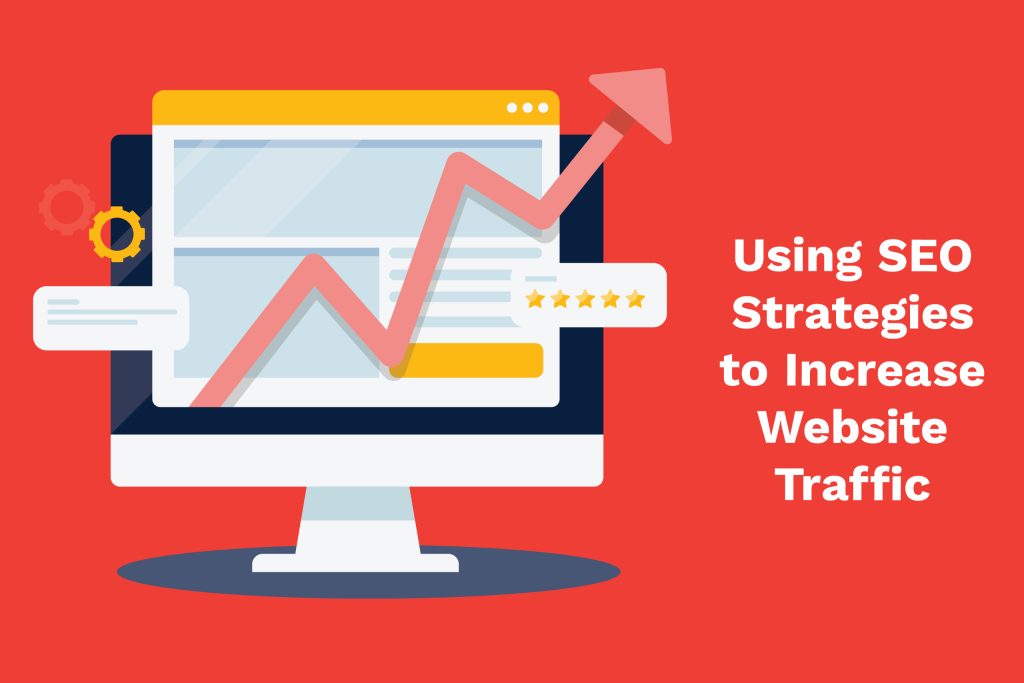Introduction
SEO is the process of optimising a website to increase its visibility and ranking on search engine results pages (SERPs). This is done by making the website more attractive to search engines, such as Google, Bing and Yahoo, by improving the website’s content, structure, and technical aspects. The higher a website ranks on SERPs, the more likely it is to be visited by users. The importance of SEO in increasing website traffic lies in the fact that the majority of internet users use search engines to find what they are looking for.

In fact, more than 90% of online experiences start with a search engine. By optimising a website for search engines, it is more likely to appear at the top of search results for relevant keywords. This can lead to an increase in website traffic and ultimately, more conversions and sales.
It is also important to mention that SEO is not a one-time process, it requires continuous monitoring and updating to keep up with search engine algorithms and user behaviour changes.
Overview of how SEO can increase website traffic
SEO can increase website traffic by:
- Improving search engine visibility: By optimising a website’s content, structure, and technical aspects, it can improve its visibility on SERPs and increase its chances of appearing at the top of search results for relevant keywords.
- Targeting the right audience: By researching and using relevant keywords, a website can attract the right audience and increase the chances of converting visitors into customers.
- Building brand awareness: Having a website that appears at the top of search results for relevant keywords can help to build brand awareness and credibility.
- Generating backlinks: Backlinks, or links from other websites that point to a website, can help to increase visibility and authority. The more high-quality backlinks a website has, the higher it will rank on SERPs.
- Creating a positive user experience: Search engines prioritise websites that provide a positive user experience. By optimising website structure, site speed, mobile optimisation and other technical SEO aspects, it can help to create a positive user experience, which can lead to an increase in website traffic.

It’s important to note that SEO is not a one-time process, it requires continuous monitoring and updating to keep up with search engine algorithms and user behaviour changes. By following best practices and implementing SEO strategies, a website can increase its visibility, attract the right audience and ultimately drive more traffic to the site.
On-page Optimisation:
On-page optimisation refers to the process of optimising the content and structure of a website to improve its visibility and ranking on SERPs.
- Using relevant keywords: Using relevant keywords in the website’s content can help search engines understand what the website is about and increase its visibility for those keywords. This can be done by researching and identifying the keywords that are relevant to the website’s content and products/services and incorporating them into the website’s content and meta tags.
- Creating high-quality content: High-quality content can help to attract and retain visitors, which can lead to an increase in website traffic. It also shows search engines that the website is a credible and trustworthy source of information.
- Optimising meta tags: Meta tags provide information about a website’s content to search engines. By optimising meta tags such as the title tag, meta description, and header tags, a website can improve its visibility and ranking on SERPs.
- Optimising images: Optimising images can help to improve website speed, which is an important ranking factor for search engines. By compressing images and using relevant keywords in the file names and alt tags, it can also help to increase visibility on image search results.

Overall, on-page optimisation can help to improve a website’s visibility and ranking on SERPs and provide a positive user experience. This can lead to an increase in website traffic and ultimately more conversions and sales.
Tips and Best Practices for Effective On-Page Optimisation:
- Conducting keyword research: Researching relevant keywords and using them in the website’s content, meta tags, and file names can help to increase visibility and ranking on SERPs.
- Creating high-quality, unique, and engaging content: High-quality, unique, and engaging content can help to attract and retain visitors, which can lead to an increase in website traffic.
- Optimising meta tags: Optimising meta tags such as the title tag, meta description, and header tags can help to improve a website’s visibility and ranking on SERPs.
- Using header tags correctly: Header tags (H1, H2, H3, etc.) help to organise content and make it more readable for both users and search engines. Use H1 tags for the main title and H2 tags for subtitles.
- Optimising images: Optimising images by compressing them and using relevant keywords in the file names and alt tags can help to improve website speed and increase visibility on image search results.
- Utilising internal linking: Internal linking can help to improve website navigation and create a positive user experience, which can lead to an increase in website traffic.
- Optimising website structure: Optimising website structure by creating a clear and logical hierarchy of content can help to improve website navigation and create a positive user experience, which can lead to an increase in website traffic.
- Creating a responsive design: Having a responsive design that adapts to different screen sizes can help to improve the user experience and increase website traffic from mobile devices.
- Creating a sitemap: Having a sitemap can help search engines to crawl and index the website’s content, which can improve visibility and ranking on SERPs.
- Regularly updating the content: Regularly updating the content can help to keep the website fresh and attract visitors, which can lead to an increase in website traffic.
Off-Page Optimisation:
Off-page optimisation refers to the process of improving a website’s visibility and ranking on SERPs by building links and creating a presence on social media.
- Building backlinks: Backlinks, or links from other websites that point to a website, can help to increase visibility and authority. The more high-quality backlinks a website has, the higher it will rank on SERPs. Backlinks can be obtained through link building campaigns, guest blogging, and directory submissions.
- Creating social media profiles: Having a presence on social media can help to increase brand awareness, attract visitors, and generate backlinks. By creating social media profiles and actively sharing and engaging with content, it can help to increase visibility and generate backlinks.

Tips and best practices for effective off-page optimisation include:
- Building high-quality backlinks: Building high-quality backlinks from reputable and relevant websites can help to increase visibility and authority.
- Creating valuable content: Creating valuable content that others will want to link to can help to generate backlinks.
- Guest blogging: Guest blogging on relevant and reputable websites can help to increase visibility, generate backlinks and attract visitors.
- Participating in online communities: Participating in online communities and forums related to the website’s niche can help to increase brand awareness and attract visitors.
- Creating social media profiles: Creating social media profiles on relevant platforms such as Facebook, Twitter, and LinkedIn can help to increase brand awareness, attract visitors, and generate backlinks.
- Actively sharing and engaging with content: Actively sharing and engaging with content on social media can help to increase visibility and generate backlinks.
- Creating shareable content: Creating shareable content such as infographics and videos can help to attract visitors and generate backlinks.
- Creating a strong brand: Creating a strong brand can help to increase visibility and generate backlinks.
- Networking with other websites: Networking with other websites and collaborating on content can help to increase visibility and generate backlinks.
- Monitoring and analysing: Regularly monitoring and analysing backlink profile, social media presence and other off-page optimisation efforts can help to identify opportunities for improvement and track progress.
Technical SEO:
Technical SEO refers to the process of optimising a website’s technical aspects to improve its visibility and ranking on SERPs.
- Website structure: A well-structured website can help to improve website navigation, create a positive user experience, and increase visibility on SERPs.
- Site speed: Site speed is a ranking factor for search engines. A fast-loading website can help to improve the user experience and increase visibility on SERPs.
- Mobile optimisation: With the increasing use of mobile devices to access the internet, mobile optimisation has become an essential aspect of SEO. A mobile-optimised website can help to improve the user experience, increase visibility on SERPs, and attract mobile visitors.

Tips and best practices for technical SEO include:
- Optimising website structure: Optimising website structure by creating a clear and logical hierarchy of content can help to improve website navigation and create a positive user experience.
- Improving site speed: Improving site speed by compressing images, minifying code, and using a content delivery network (CDN) can help to increase visibility and improve the user experience.
- Creating a responsive design: Having a responsive design that adapts to different screen sizes can help to improve the user experience and increase website traffic from mobile devices.
- Creating a sitemap: Having a sitemap can help search engines to crawl and index the website’s content, which can improve visibility and ranking on SERPs.
- Using structured data: Using structured data, such as schema markup, can help to provide additional information to search engines, which can improve visibility and ranking on SERPs.
- Monitoring and analysing: Regularly monitoring and analysing website’s performance and technical aspects can help to identify opportunities for improvement and track progress.
- Securing the website: A website should be secured with an SSL certificate to establish secure connections and prevent hacking attempts.
- Creating a mobile-friendly website: Having a mobile-friendly website can help to improve the user experience and increase visibility on SERPs.
- Creating a proper redirects: Proper redirects can help to maintain link equity and avoid 404 errors when changing website’s structure or content.
- Creating a proper 404 error pages: Having a proper 404 error page can help to handle broken links and improve the user experience.
Also Read 10 Benefits of SEO for Your Business
Measuring and analysing SEO results:
Measuring and analysing SEO results is important to understand how well the SEO efforts are performing and where to focus on for future improvements.
- Importance of measuring and analysing SEO results: Measuring and analysing SEO results can help to understand the effectiveness of SEO efforts, identify areas for improvement, and track progress over time. By monitoring and analysing website traffic, keyword rankings, backlink profile, and other relevant metrics, it can help to make data-driven decisions and optimise SEO efforts for better results.
- Using Google Analytics and Search Console: Google Analytics and Search Console are both free tools provided by Google that can be used to track and analyse website traffic.
Google Analytics is a web analytics service that tracks and reports website traffic. It can be used to monitor website traffic, track user behaviour, and identify areas for improvement.
Google Search Console is a webmaster tool that provides insights into a website’s performance on Google search. It can be used to track keyword rankings, monitor backlink profile, and identify technical issues that can impact visibility on SERPs.
Here are some ways to use Google Analytics and Search Console to track and analyse website traffic:
- Setting up goals: Setting up goals in Google Analytics can help to track conversions and understand how well the website is performing in terms of achieving its objectives.
- Tracking website traffic: Google Analytics can be used to track website traffic, including the number of visitors, pages per session, and bounce rate.
- Identifying referral sources: Google Analytics can be used to identify referral sources, such as search engines, social media, or other websites, that are driving traffic to the website.
- Analysing user behaviour: Google Analytics can be used to analyse user behaviour, including the pages visited, time on site, and actions taken on the website.
- Tracking keyword rankings: Google Search Console can be used to track keyword rankings and monitor how well the website is performing for specific keywords.
- Monitoring backlink profile: Google Search Console can be used to monitor the website’s backlink profile, including the number of backlinks, linking domains, and the quality of the linking websites.
- Identifying technical issues: Google Search Console can be used to identify technical issues that can impact visibility on SERPs, such as broken links, crawl errors, and mobile usability issues.
By using these tools and analysing the data they provide, it can help to make informed decisions and optimise SEO efforts for better results.
Conclusion:
In summary, the blog post discussed how SEO can increase website traffic by improving search engine visibility, targeting the right audience, building brand awareness, generating backlinks and creating a positive user experience. It also provided an overview of different aspects of SEO, including on-page optimisation, off-page optimisation, technical SEO and measuring and analysing SEO results. It also provided tips and best practices for effective SEO.
To further learn about SEO and increasing website traffic, here are some Additional resources:
- Moz’s Beginner’s Guide to SEO: https://moz.com/beginners-guide-to-seo
- Google Analytics Academy: https://analytics.google.com/analytics/academy/
- Google Search Console Help Centre: https://support.google.com/webmasters/answer/4559176?hl=en
It’s also worth noting that SEO is a constantly changing field, and it’s important to stay updated with the latest trends and best practices. And also it’s important to remember that SEO is a long-term strategy, it may take some time to see the results.













